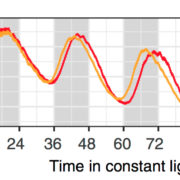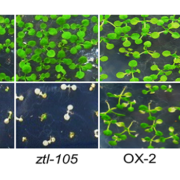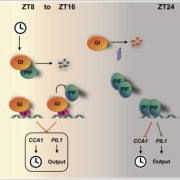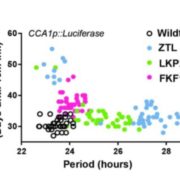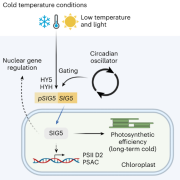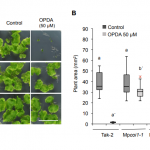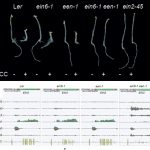Coordination of circadian times in Arabidopsis seedlings (PLOS Biol)
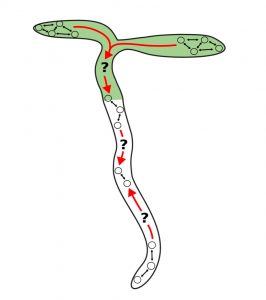 Precise temporal control is crucial for plant developmental processes, e.g., photosynthesis, leaf movement, and flowering. In this work, Greenwood et al. studied how rhythms are coordinated at the whole-organism level. The authors monitored the activity of GIGANTEA (GI), a core clock gene, using a LUCIFERASE reporter gene in Arabidopsis seedlings. GI:LUC expression showed different peaks across the plant, indicating different clock rhythms among organs. Several spatial waves of GI gene expression were detected in the plant. In the cotyledons the wave propagated from the tip down through the hypocotyl, and another wave started from the root junction going upwards. Additionally, two different waves were detected in the roots, one starting in the hypocotyl junction going downwards and another from the root tip moving upwards. To test if these expression waves were driven by long-distance communication, the authors monitored the rhythms in excised cotyledons, roots, and root tips, and found that clocks across the plant are coordinated via local cell-cell signaling and are independent of a long-distance signal. Finally, they tested different metabolic inputs (e.g., sugars, inhibitors of photosynthesis) and genetic elements (e.g., phytochrome mutants) to investigate their effects on plant-wide circadian clock gene expression. (Summary by Humberto Herrera-Ubaldo) PLOS Biol. 10.1371/journal.pbio.3000407
Precise temporal control is crucial for plant developmental processes, e.g., photosynthesis, leaf movement, and flowering. In this work, Greenwood et al. studied how rhythms are coordinated at the whole-organism level. The authors monitored the activity of GIGANTEA (GI), a core clock gene, using a LUCIFERASE reporter gene in Arabidopsis seedlings. GI:LUC expression showed different peaks across the plant, indicating different clock rhythms among organs. Several spatial waves of GI gene expression were detected in the plant. In the cotyledons the wave propagated from the tip down through the hypocotyl, and another wave started from the root junction going upwards. Additionally, two different waves were detected in the roots, one starting in the hypocotyl junction going downwards and another from the root tip moving upwards. To test if these expression waves were driven by long-distance communication, the authors monitored the rhythms in excised cotyledons, roots, and root tips, and found that clocks across the plant are coordinated via local cell-cell signaling and are independent of a long-distance signal. Finally, they tested different metabolic inputs (e.g., sugars, inhibitors of photosynthesis) and genetic elements (e.g., phytochrome mutants) to investigate their effects on plant-wide circadian clock gene expression. (Summary by Humberto Herrera-Ubaldo) PLOS Biol. 10.1371/journal.pbio.3000407


